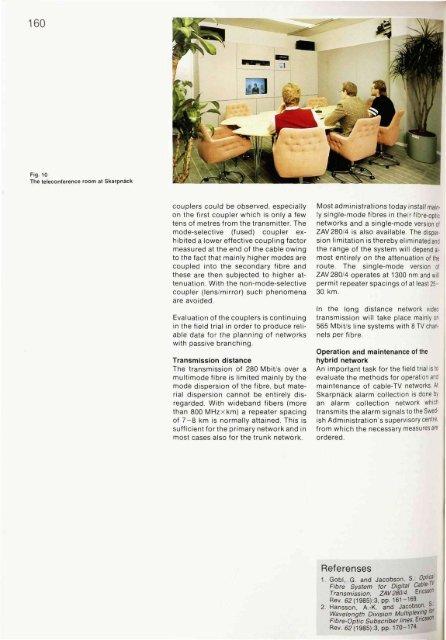Field Trial of Optical Fibre Cable-TV System Optical Fibre System for ...
Field Trial of Optical Fibre Cable-TV System Optical Fibre System for ...
Field Trial of Optical Fibre Cable-TV System Optical Fibre System for ...
You also want an ePaper? Increase the reach of your titles
YUMPU automatically turns print PDFs into web optimized ePapers that Google loves.
160<br />
Fig. 10<br />
The teleconference room at Skarpnäck<br />
couplers could be observed, especially<br />
on the first coupler which is only a few<br />
tens <strong>of</strong> metres from the transmitter. The<br />
mode-selective (fused) coupler exhibited<br />
a lower effective coupling factor<br />
measured at the end <strong>of</strong> the cable owing<br />
to the fact that mainly higher modes are<br />
coupled into the secondary fibre and<br />
these are then subjected to higher attenuation.<br />
With the non-mode-selective<br />
coupler (lens/mirror) such phenomena<br />
are avoided.<br />
Evaluation <strong>of</strong> the couplers is continuing<br />
in the field trial in order to produce reliable<br />
data <strong>for</strong> the planning <strong>of</strong> networks<br />
with passive branching.<br />
Transmission distance<br />
The transmission <strong>of</strong> 280 Mbit/s over a<br />
multimode fibre is limited mainly by the<br />
mode dispersion <strong>of</strong> the fibre, but material<br />
dispersion cannot be entirely disregarded.<br />
With wideband fibers (more<br />
than 800 MHzxkm) a repeater spacing<br />
<strong>of</strong> 7-8 km is normally attained. This is<br />
sufficient <strong>for</strong> the primary network and in<br />
most cases also <strong>for</strong> the trunk network.<br />
Most administrations today install mainly<br />
single-mode fibres in their fibre-optic<br />
networks and a single-mode version <strong>of</strong><br />
ZAV 280/4 is also available. The dispersion<br />
limitation is thereby eliminated and<br />
the range <strong>of</strong> the system will depend almost<br />
entirely on the attenuation <strong>of</strong> the<br />
route. The single-mode version <strong>of</strong><br />
ZAV 280/4 operates at 1300 nm and will<br />
permit repeater spacings <strong>of</strong> at least 25-<br />
30 km.<br />
In the long distance network video<br />
transmission will take place mainly on<br />
565 Mbit/s line systems with 8 <strong>TV</strong> channels<br />
per fibre.<br />
Operation and maintenance <strong>of</strong> the<br />
hybrid network<br />
An important task <strong>for</strong> the field trial is to<br />
evaluate the methods <strong>for</strong> operation and<br />
maintenance <strong>of</strong> cable-<strong>TV</strong> networks. At<br />
Skarpnäck alarm collection is done by<br />
an alarm collection network which<br />
transmits the alarm signals to the Swedish<br />
Administration's supervisory centre,<br />
from which the necessary measures are<br />
ordered.<br />
Referenses<br />
1. Gobi, G. and Jacobson, S.: Optics!<br />
<strong>Fibre</strong> <strong>System</strong> <strong>for</strong> Digital <strong>Cable</strong>- iv<br />
Transmission, ZAV280/4. Ericsson<br />
Rev. 62 (1985):3, pp. 161-169.<br />
2. Hansson, A.-K. and Jacobson, »••<br />
Wavelength Division Multiplexing w<br />
<strong>Fibre</strong>-Optic Subscriber lines. Encsso<br />
Rev. 62(1985):3, pp. 170-174.
















